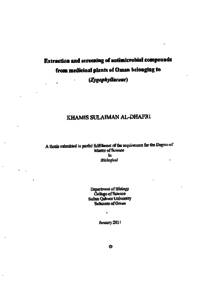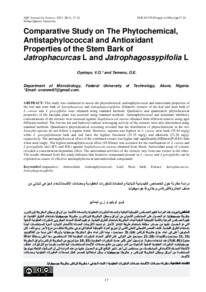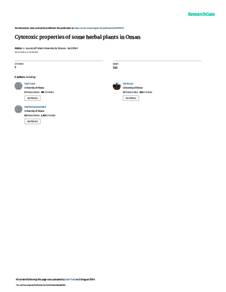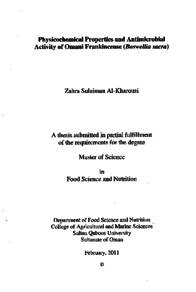Document
Extraction and screening of antimicrobial compounds from medicinal plants of Oman belonging to (Zygophyllaceae)
Publisher
Sultan Qaboos University
Gregorian
2011
Language
English
English abstract
Eight species of ethnomedicinal plants belonging to Zygophyllaceae from Oman were selected: Fagonia bruguieri, Fagonia indica, Fagonia socotrana, Seetzenia lanata, Tribulus pentanadrus, Tribulus tertrestris, Tetraena qatarense, Tetraena simplex. These plants are traditionally used in the treatment of various illness and body disorders. Ethanolic extracts were fractionated and screened for antimicrobial activity against different strains of human pathogenic bacteria and fungi such as Staphylococcus aureus, Bacillus subtilis, Escherichia coli, Pseudomonas aeruginosa, Enterobacter faecalis and Cladosporum herbarum. The tests were carried out using agar diffusion method and bioautography. In addition to this different fractions were isolated from the crude extract using solvents of wide ranging polarity (95% ethanol, ethyl acetate, petroleum ether, n butanol, and aqueous) with HPLC and GC. Each fraction represented different active compound, but the ethanol and aqueous fractions shown more active compounds. The percentage yield and inhibition zone diameter of the ethanol extract and its fractions were determined and the data were statistically analyzed. The efficiency of different fractions was compared by measuring the clearing zones. Of all the plants tested, Fagonia indica, Tribulus pentandrus, and Tetraena simplex were found to be more effective against bacterial and fungal strains. Brine Shrimp lethality test was used to determine LC50 of plant extracts. For ethanol extract LC50 indicated that Fagonia species and Seetzeinia lanata are more effective than Tribulus and Tetraena species. All selected species were found to have antimicrobial activity on at least two microbial strains. The antimicrobial activity profile showed that E. coli is the most resistant among the tested strains.
The results indicate the potential of these medicinal plants in treating microbial infections of the body.
Member of
Resource URL
Arabic abstract
يتناول هذا البحث إستعراض خصائص مقاومة مستخلص ثمانية أنواع من النباتات من العائلة القديسية أو الرطراطية وهي: ( الشكاع ، حليمه/شكاع ، حبین/ ابوشوکه ، حلوات البيدار ، ام قرین شرشير ، هرم رطریط ، وأبو رقيبه) ، ومقاومتها للكائنات الدقيقة كالبكتيريا من مثل :
Staphylococcus aureus (NCTC6571), Bacillus subtilis (ATCC 6059), Escherichia coli (NCTC 10418), Pseudomonas aeruginosa (NCTC 10662), and Enterobacter faecalis ATCC .(29212
وباستخدام أحد أنواع الفطريات الأكثر إنتشارفي التجارب العلمية Cladosporium herbarum.
وذلك من خلال إختبار مستخلص النباتات بطرق تغيير المادة المنيبة لمكونات النبات كل على حدة. ولقد تتبع البحث بمقارنة الطرق المستخدمة في الطب الشعبي في علاج مختلف الأمراض التي قد تصيب الإنسان او الكائنات الحية الأخرى والطرق الحديثة في عملية إستخلاص تلك المضادات الحيوية. ومن ثم
إختبار المواد المستخلصة بإستخدام البكتيريا والكائنات الحية الأخرى لبحث مدى مقاومة الكائنات الحية
الدقيقة للمواد المستخلصة ومعرفة أي المواد المذيبة أفضل في إستخلاص مركبات النباتات محل البحث وأيها اكثرفاعلية في التخلص أو علاج الأمراض المختلفة. وقد توصلت هذه الدراسة من خلال العديد من التحاليل والتجارب المخبرية أن الطرق المحلية الشعبية القديمة (سواءا بغلي النبته او طحنها مباشرة بالماء واستخدام العصارة) لها صلاحيتها في طرقها لإستخلاص المادة المهمة في الإنتفاع من كل ما تقدمه البيئة من خيرات عظيمة لخدمة جميع المخلوقات على الأرض إكراما من الله لجميع ما يحب به الحياة .
Staphylococcus aureus (NCTC6571), Bacillus subtilis (ATCC 6059), Escherichia coli (NCTC 10418), Pseudomonas aeruginosa (NCTC 10662), and Enterobacter faecalis ATCC .(29212
وباستخدام أحد أنواع الفطريات الأكثر إنتشارفي التجارب العلمية Cladosporium herbarum.
وذلك من خلال إختبار مستخلص النباتات بطرق تغيير المادة المنيبة لمكونات النبات كل على حدة. ولقد تتبع البحث بمقارنة الطرق المستخدمة في الطب الشعبي في علاج مختلف الأمراض التي قد تصيب الإنسان او الكائنات الحية الأخرى والطرق الحديثة في عملية إستخلاص تلك المضادات الحيوية. ومن ثم
إختبار المواد المستخلصة بإستخدام البكتيريا والكائنات الحية الأخرى لبحث مدى مقاومة الكائنات الحية
الدقيقة للمواد المستخلصة ومعرفة أي المواد المذيبة أفضل في إستخلاص مركبات النباتات محل البحث وأيها اكثرفاعلية في التخلص أو علاج الأمراض المختلفة. وقد توصلت هذه الدراسة من خلال العديد من التحاليل والتجارب المخبرية أن الطرق المحلية الشعبية القديمة (سواءا بغلي النبته او طحنها مباشرة بالماء واستخدام العصارة) لها صلاحيتها في طرقها لإستخلاص المادة المهمة في الإنتفاع من كل ما تقدمه البيئة من خيرات عظيمة لخدمة جميع المخلوقات على الأرض إكراما من الله لجميع ما يحب به الحياة .
Category
Theses and Dissertations




